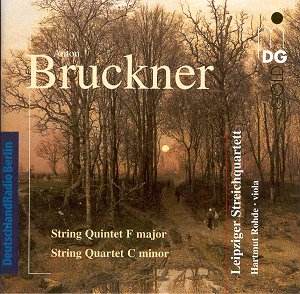The idea of chamber
music generally bespeaks a certain intimacy
of scale - not one of Anton Bruckner's
conspicuous strengths. Indeed, to all
intents and purposes, the F major Quintet
is simply another of the devout Austrian's
heaven-storming symphonies, decked out
in minimal instrumental garb. The composer's
standard harmonic and structural tics
all come into play: the emphatic octave
climaxes, the harmonic pivots from flat
keys into distantly related tonal regions
in sharps, the codas emphatically banging
away at the tonic chord. And, at forty-five
minutes and change, the piece is of
comparably symphonic duration as well.
The Leipzig Quartet
members, and their guest violist, acknowledge
the scope of this music with a big-boned,
firm-bowed sound, providing even the
semiquavers a sense of breadth, and
infusing the moving parts in the chorales
(as at the Adagio's opening)
with full tonal weight. They understand
the music's proportions, eliciting expression
from details, but never to the detriment
of the music's long, arching structures.
Their intonation is consistently impeccable:
the most tortuous harmonic side-steps
are "placed" precisely, while simple
passages in thirds sing vibrantly. And,
while the players know how to project
the music's lyric grandeur, they don't
neglect the relaxed, rustic charm of
its Austrian folk elements.
Against this, an erratic
attitude to dynamics is a small but
definite minus. Bruckner, as an organist,
knew how to use terraced dynamics for
dramatic effect, and did so extensively:
the score abounds in sudden drops to
piano or pianissimo. Sometimes,
when all five players make the adjustment
(as at 4:32 in the Adagio), the
effect evokes the awe the composer surely
meant to suggest. But other such opportunities
are completely missed, with no audible
change at all (at 0:59 and again at
5:47 of the Scherzo). In still
other places, leader Andreas Seidel
gets markedly softer than everyone else,
so the desired contrast is indicated
rather than fully realized.
And the playing, sturdy
and dead in tune as it is, isn't really
suave. Seidel's tone can be momentarily
grainy at the start or end of phrases.
Solo second violin passages expose Tilman
Büning's scrawny, whitish sound
- though, given the frequent violin
part-crossings, this actually helps
the ear distinguish the voices. And
cellist Matthias Moosdorf hammers away
overbearingly at the first-movement
coda's repeated Fs. But the players'
fervent commitment ultimately convinces.
Besides, modern alternatives aren't
exactly thick on the ground. L'Archibudelli's
Sony recording is excellent, but they're
"period" players who use gut strings,
to lovely but markedly different effect.
The C minor Quartet,
a student work with a strongly classical,
Beethovenesque profile, stands in the
same relation to the Quintet that the
F major "Study Symphony" - the one the
French call "Double Zéro"
- does to the canonical symphonies.
Still, the second subject of the opening
Allegro moderato evinces some
of the familiar liquid misterioso
quality, with the occasional moment
of soaring lyricism hinting at the beauties
to come. I didn't have access to a score
to check on dynamics, but I doubt this
early work calls for many sudden level
changes, and the players certainly sound
fine.
Stephen Francis
Vasta


